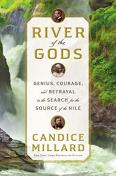
by Candice Millard
Hardcover- $26.99
NEW YORK TIMES BESTSELLER • The harrowing story of one of the great feats of exploration of all time and its complicated legacy—from ...
Overall rating:
How would you rate this book?
Member ratings
Concentrating on the lives of three unusual men, Richard Burton, John Hanning Speke, and Sidi Mubarak Bombay, Millard explores the details of their varied expeditions and relationships as they searched for, among other things, the origin of The White Nile. Each man, unusual in his own way, carved a place in history, each having his own greater or lesser impact. Speke and Burton were notably without religious faith. Speke betrayed Burton because he was so jealous of Burton’s success. Burton was anti-Semitic and both of them were racist. Burton believed in polygamy and uses for human skin which I found unspeakable. Bombay was a Muslim who had once been a slave, captured in East Africa and shipped to India. He became a guide for Speke and Burton. He was loyal and devoted to them.
Ultimately, although Speke was not lauded in posterity, he did discover the origin of the White Nile and was correct in his assumption that it began at the Nyanza River, fed by smaller tributaries, not the Tanganyika River as Burton had insisted. Speke and Burton’s relationship was contentious and competitive. Their jealousy and competition, coupled with the politics of the military and other foundations funding their expeditions, made successfully organizing and funding their journeys more difficult. Bombay remained loyal to both of them long after the expeditions came to an end, and he continued to explore and map the African continent as Burton and Speke had endeavored to do. He was with the famed Stanley when he found the missing Dr. Livingstone.
Speke and Burton spent much of their lives in conflict with each other. Their preferences tended to the extraordinary, especially Burton’s, who made most of his money from publishing books that would make his readers blush and Victorian England glower though they read the pornography behind closed doors. From his technical books, he made little money. In the end, his wife, Isabel, burned his last book, which was almost complete, because although she was offered large sums, she wanted to save his soul. She took years to gather her courage to defy her mother’s objections to their marriage and they seemed to remain apart unnecessarily, at times. She was, however, completely devoted to him.
The book also elaborately covers the details of the East African slave trade which once held Bombay captive and explains his efforts in that regard. The slave trade in East Africa continued into the early twentieth century, long after it ended in most other countries. So you see, although it is depicted as a book about an expedition to discover where the White Nile initiated, there was a great deal of other extraneous material which often distracted from the main theme. There was violence and there were grave injuries, illness, battles, dangerous insects, disasters, and horrific living conditions that caused death and disease. Conflicts that caused tumultuous relationships, sometimes seemed more intense than the search for the Nile’s headwaters. Famous names like Charles Darwin, Henry Morton Stanley and David Livingstone drip from the pen, but they have little to do with the discovery of the Nile’s beginning and were merely interesting interjections.
“The River of Doubt”, Millard’s last book with a similar name, was more exciting and engaging. I found the most interesting part of the book to be the end, the Epilogue, but there were other interesting extraneous facts throughout the book, like who the cardigan sweater was named after, the origin of the raglan sleeve and the Battle of Balaclava during the Crimean War which was the reason the poem, “The Charge of the Light Brigade” was written by Lord Alfred Tennyson.
Book Club HQ to over 90,000+ book clubs and ready to welcome yours.
Get free weekly updates on top club picks, book giveaways, author events and more








